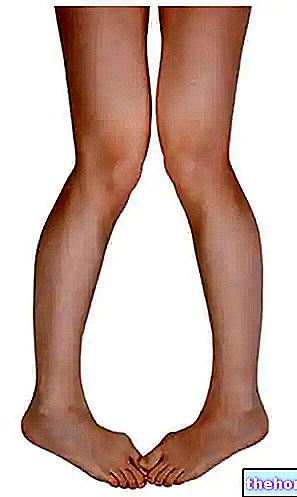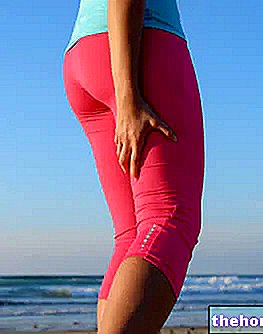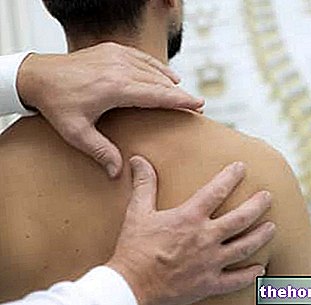Generality
Kyphosis is a "pathological accentuation of the curvature that characterizes the spinal column in its thoracic section.
In fact, the term kyphosis has a different meaning; in fact it would indicate the physiological curve formed by the thoracic vertebrae. However, its use with a "pathological meaning is so widespread that it has now replaced more precise terminologies, such as" pathological kyphosis "or" hyperkyphosis ".

If present, the classic symptoms of dorsal hyperkyphosis consist of: back pain, back stiffness, pain in the spine and a tendency to easy fatigue.
For an accurate diagnosis, physical examination and imaging are essential.
Therapy depends on the severity of the kyphosis.
What is kyphosis?
Kyphosis is the term which, in common jargon, indicates an "accentuation of the characteristic curvature, with an anterior concavity, that the vertebral column forms in its thoracic tract.
In fact, it would be more correct to define "kyphosis" the physiological anterior concavity of the vertebral thoracic tract and "pathological kyphosis" or "hyperkyphosis" the excessive accentuation of this curvature.
However, the "use of the word" kyphosis "with a" pathological meaning is now so widespread that it no longer arouses particular criticism even from the medical community.
In specialist jargon
Specialists speak of pathological kyphosis when the so-called angle of kyphosis exceeds 45 °.
Under normal conditions, the angle of the kyphosis measures between 20 ° and 45 °.

Image from the site: http://krauthammerlab.med.yale.edu/
BRIEF ANATOMICAL REVIEW OF THE SPINE
The backbone of the human body, the vertebral column or rachis is a bone structure that in adults measures about 70 centimeters.
Composed of 33-34 vertebrae stacked on top of each other, according to the most classic of anatomical subdivisions, the vertebral column has 5 sections:
- The cervical section, which includes 7 vertebrae, called the cervical vertebrae.
- The thoracic section, which includes 12 vertebrae, called the thoracic vertebrae.
- The lumbar section, which includes 5 vertebrae, called the lumbar vertebrae.
- The sacral section, which includes 5 vertebrae, called the sacral vertebrae.
- The coccygeal section, which includes 4 vertebrae, called the coccygeal vertebrae.

The vertebral holes of each vertebra coincide and this determines the formation of a long canal, which serves to house the spinal cord.
The spinal cord is, together with the brain, one of the two elements that make up the central nervous system.

Causes
Pathological kyphosis can arise for a variety of reasons, including:
- Poor posture (postural kyphosis)
- The presence of morphological anomalies in the vertebrae (Scheuermann's kyphosis)
- An abnormal development of the spinal column during intrauterine life (congenital kyphosis)
- The advanced age
- A spinal injury
POSTURAL KYPHOSIS
Postural kyphosis is the result of bad posture attitudes, which produce an inappropriate lengthening of the ligaments and muscles, responsible for supporting the thoracic vertebrae. This lengthening modifies the normal position of the thoracic vertebrae and permanently accentuates the anterior concavity formed by the thoracic section of the rachis.
Poor posture kyphosis is more common among young people, as these people have a spine that is easier to shape than an adult.
Classic bad posture attitudes are:
- Stand upright with your arms dangling. This posture is also known as a drooping posture.
- Lean with the thoracic section of the spine against the back of the chair.
- If you regularly use a backpack, load it with excessive weight.

Figure: left, example of a drooping posture
KYPHOSIS OF SCHEUERMANN
Also known as juvenile kyphosis, Scheuermann's kyphosis is the most common form of pathological kyphosis among the young population.
Its onset is due to an incorrect development of the vertebral bodies, which, instead of having the classic cylindrical-rectangular shape, take on a triangular-conical appearance.
This incorrect development of the vertebral bodies usually occurs during childhood.
From a strictly medical point of view, Scheuermann's kyphosis is a form of osteochondrosis, involving the vertebrae.
The causes that determine the incorrect development of the vertebral bodies are unclear: according to experts, Scheuermann's kyphosis would have a "multifactorial origin.
CONGENITAL KYPHOSIS
Those who suffer from congenital kyphosis are born with a spinal column with abnormal characteristics.
Generally, these anomalous characteristics derive from a fusion process of two or more vertebrae; more rarely, they are the effect of a prenatal malformation of the vertebral bodies.
Currently, despite numerous researches, doctors and researchers are unaware of exactly what alters the intrauterine development of the spinal column.
KYPHOSIS DUE TO AGING
Following the natural aging process, the spinal column undergoes various morphological changes, which, in some individuals, are the cause of more or less severe pathological kyphosis.
Morphological changes in the spine are related to various factors, including:
- A change in the muscle structure of the back.
- Alterations to the ligaments that support the vertebrae of the spine.
- Bad posture attitudes.
OTHER CAUSES
Other possible causes of kyphosis are:
- Osteoporosis: In the presence of osteoporosis, the bones become weaker and more susceptible to fractures.
- Spondylosis: it is a particular form of arthritis, which deforms the intervertebral bodies and discs.
- Spina bifida: it is a morbid condition that involves an abnormal development of the spinal column.
- Paget's disease: its presence coincides with an "alteration of bone remodeling and a weakening of the bones.
- Neurofibromatosis: is a genetic disease that affects the nervous system.
- Muscular dystrophy: it is a genetic disease that affects the good health of the muscles.
- Tuberculosis: is a "bacterial infection that mainly affects the lungs.
- A spinal tumor.
Symptoms and Complications
Mild pathological kyphoses can be both asymptomatic - that is, without obvious signs and symptoms - and responsible for some characteristic clinical manifestations, such as:
- Back pain.
- Sense of stiffness in the back.
- Soreness in the spine.
- Tendency to easy fatigue. In people with pathological kyphosis, the muscles and ligaments of the back are subject to greater stress than in people with a normal spine. This increased stress causes fatigue and tiredness more easily.
In general, the more severe the kyphosis, the more likely the affected person is to complain of the aforementioned symptoms.
AESTHETIC DISCOMFORT
Especially in young people, kyphosis can induce a certain aesthetic discomfort, due to the abnormal shape it gives to the back.
Even if it is not a symptom of kyphosis, this discomfort can affect, and not a little, the life of those who feel it.
COMPLICATIONS
Complications of kyphosis usually arise when the accentuation of the anterior concavity of the spine is noticeable.
In other words, those with severe pathological kyphosis are more at risk of complications.
Possible complications of kyphosis are:
- Presence of persistent pain that does not respond to treatment with pain medication.
- Presence of breathing difficulties. These difficulties appear due to the compression exerted by the spinal column to damage the lungs and airways.
- Presence of nervous system disorders. These disorders arise due to the crushing operated by the spinal column to damage the nerves that run nearby.
Some classic symptoms of this complication are: numbness or weakness in the arms or legs, balance problems, loss of bladder function control, and loss of bowel function control.
Complications of kyphosis require medical attention and, very often, require surgery.
Diagnosis
For the diagnosis of kyphosis, it is essential to perform an accurate physical examination and some diagnostic imaging tests, such as: X-rays, CT and / or nuclear magnetic resonance.
The use of other methods of investigation occurs in particular cases of kyphosis: for example, if the patient shows suspicious signs of tuberculosis, the doctor could prescribe blood tests; if instead the patient is an elderly person with probable osteoporosis, the doctor your healthcare provider may prescribe a measurement of your bone mass (bone densitometry).
OBJECTIVE EXAMINATION
During a classic physical examination for the evaluation of a kyphosis, the doctor carefully observes the patient's spine, while asking him to perform some particular movements with his back.
Based on how the patient performs the aforementioned movements, the doctor is very often able to identify the presence or absence of kyphosis.

IMAGE DIAGNOSTICS
X-rays, CT (or Computed Axial Tomography) and nuclear magnetic resonance (MRI) provide useful information on the precise characteristics of kyphosis (severity, involvement of neighboring nervous structures, contact of the spinal column with other organs, etc.).
Treatment
In case of kyphosis, treatment depends on the degree of accentuation of the curvature in the thoracic level and on the causes that induced this curvature.
Exist:
- kyphosis so mild and with causes not particularly worrying, which do not require any treatment;
- kyphosis of mild to moderate severity and correctable causes, which require the administration of painkillers and the execution of certain exercises for postural improvement and muscle strengthening (physiotherapy);
- severe kyphosis and causes important from the pathological point of view, which make even surgical intervention indispensable.
EFFECTS OF PAIN RELIEF AND PHYSIOTHERAPY
Pain relievers and physiotherapy exercises for posture improvement and back muscle strengthening have the primary purpose of reducing pain.
In some cases, physiotherapy may also be useful in improving the outward appearance of the thoracic section of the spine.
SURGERY
The surgery for kyphosis - known as spinal fusion for kyphosis - allows to correct the excessively accentuated curvatures of the thoracic section of the spine and to reduce the risk of complications (obviously in those cases where the risk of complications is high).
To be precise, doctors recommend the use of surgery in the presence of severe kyphosis and for which the benefits obtainable through the surgical operation outweigh the dangers of the latter. It is indeed important to remind readers that spinal fusion for kyphosis is a very delicate and complex operation (it can take from 4 to 8 hours).
Briefly, from an operational point of view, spinal fusion for kyphosis consists in fusion together two or more vertebrae, through the use of bone grafts, metal plates and screws.
The fusion of the vertebrae aims to restore, at least in part, the normal thoracic curvature of the spine.
Performed under general anesthesia, the spinal fusion operation requires a hospitalization of about a week and the use of a brace (commonly called "shoulder straightener") for at least 9 months.
Examples of classic circumstances in which kyphosis requires surgery:
- When the curvature of the thoracic section of the spine is very pronounced.
- When the curvature causes severe pain and pain medications are completely ineffective.
- When the curvature hinders some important vital functions, such as breathing properly.
- When, in the absence of surgery, doctors predict further worsening of kyphosis.
CAN THE USE OF A GUARDIAN BE USEFUL?
Doctors sometimes recommend the use of a brace or shoulder straightener for young patients with moderate kyphosis.
In these situations, the purpose of the shoulder straightener is to avoid a worsening of the curvature.
Initially, the use of a brace for kyphosis can be uncomfortable, but then, very often, the patient gets used to it.
Prevention
The only type of kyphosis for which safe preventive measures exist is postural kyphosis.
These preventive measures consist of:
- Avoid assuming the so-called drooping posture
- Sit properly
- If you use a backpack on a daily basis, avoid loading it with too many weights
- Regularly engage in physical activities, which involve stretching the back muscles. Swimming, running, long walks, yoga and pilates are among the most recommended motor activities for the prevention of pathological postural kyphosis.




























